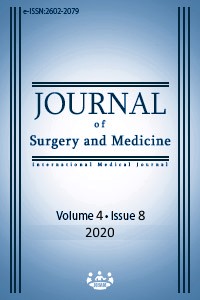Assessment of ear metric properties in young Turkish adults
Keywords:
pinnae, metric, aesthetic, anatomyAbstract
Aim: The ear is a critical component of the human face functionally and aesthetically. Studies in recent years have reported that the morphological properties of the outer ear show substantial differences based on sex and ethnic group. The data obtained in these studies are guiding for plastic surgeons. Methods: This cross-sectional study was carried out on a Turkish population. Ear axis, antihelix angle, ear length, ear width, earlobe length and earlobe width measurements were made on 191 healthy adult volunteers (106 women, 85 men) between the ages of 18-25 years. Ear metric values mentioned above were compared between the genders, and correlation analysis was conducted for all. Results: All values except the antihelix angle were larger in males (P=0.0486; P<0.001; P=0.004; P<0.001; P=0.038 for ear axis, length, width, ear lobule length and width respectively). The ear axis was positively correlated with the antihelix angle, the ear width and the ear lobule width and the ear length was positively correlated with the ear width and ear lobule length (P<0.001 for both). Conclusion: Although our study has some limitations it includes noteworthy data about outer ear metric values of the young adult Turkish population which we believe is going to be beneficial to standardization and optimization in ear surgery.
Downloads
References
Pham TV, Early SV, Park SS. Surgery of the auricle. Facial Plast Surg. 2003;19(1):53-74.
Alexander KS, Stott DJ, Sivakumar B, Kang N. A morphometric study of the human ear. J Plast Reconstr Aesthet Surg. 2011;64(1):41-7.
Senthil Kumar B, Panneer Selvi G. Morphometry of Ear Pinna in Sex Determination. Int J Anat Res. 2016;4(2):2480-4.
Krishan K, Kanchan T, Thakur S. A study of morphological variations of the human ear for its applications in personal identification. Egypt J Forensic Sci. 2019;9(6). doi:.10.1186/s41935-019-0111-0
Verma P, Sandhu HK, Verma KG, Goyal S, Sudan M, Ladgotra A. Morphological Variations and Biometrics of Ear: An Aid to Personal Identification. J Clin Diagn Res. 2016;10(5):138-42.
Cubitt JJ, Chang LY, Liang D, Vandervord J, Marucci DD. Auricular reconstruction. J Paediatr Child Health. 2019;55(5):512-7.
Pittayapat P, Jacobs R, Bornstein MM, Odri GA, Lambrichts I, Guy Willems G, et al. Three-dimensional Frankfort horizontal plane for 3D cephalometry: a comparative assessment of conventional versus novel landmarks and horizontal planes. Eur J Orthod. 2018;40(3):239-48.
Meiyappan N, Tamizharasi S, Senthilkumar KP, Janardhanan K. Natural head position: An overview. J Pharm Bioallied Sci. 2015;7(2):424-7.
Claes P, Reijniers J, Shriver MD, Snyders J, Suetens P, Nielandt J, et al. An investigation of matching symmetry in the human pinnae with possible implications for 3D ear recognition and sound localization. J Anat. 2015;226(1):60-72.
Japatti SR, Engineer PJ, Reddy BM, Tiwari AU, Siddegowda CY, Hammannavar RB. Anthropometric Assessment of the Normal Adult Human Ear. Ann Maxillofac Surg. 2018;8(1):42-50.
Surmeli M, Deveci I, Canakci H, Canpolat MS, Karabulut B, Yilmaz AAS. Effect of Body Mass Index on Auricular Morphology and Auditory Functions. Ear Nose Throat J. 2019;98(7):E81-E86.
Çalışkan S, Çeti̇n H, Akkaşoğlu S. Morphometry of the external auditory canal: Radiological study. J Surg Med. 2020;4(1):76-9.
Downloads
- 507 892
Published
Issue
Section
How to Cite
License
Copyright (c) 2020 Emine Petekkaya, Sema Özandaç Polat, Ayşe Gül Kabakcı, Yiğit Çevik
This work is licensed under a Creative Commons Attribution-NonCommercial-NoDerivatives 4.0 International License.
















